Explainer
- Explainer
- Middle East tensions
‘It’s mayhem’: Can all-out war in Lebanon be prevented?
Why has the conflict over the Israel-Lebanon border escalated? How bad is it looking? And what do Iran and the US want to happen?
By Gemma Grant, Angus Holland and Jackson Graham
On the freeways that lead out of southern Lebanon, lines of traffic stretch as far as the eye can see. Families have bundled a few belongings into cars, desperately seeking refuge further north. For almost a year, violence has been knocking at the doors of those living near the border with Israel. On September 23, it burst into their lives with just a few hours warning by text message, apparently sent through a hacked phone network: “If you are in a building housing weapons for Hezbollah, move away from the village until further notice.”
Bombs then fell across neighbourhoods, killing more than 500 people – Lebanon’s deadliest day since its 15-year civil war that ended in 1990. “It’s mayhem on the roads,” Daizy Gedeon, an Australian-Lebanese filmmaker, told us from Beirut in the days following. “It’s been horrifying.” Housing across the city was scarce, she said. Schools had closed, with classrooms converted into crisis accommodation for the thousands fleeing.
Across Beirut, there were calls for bedding, food, water, baby supplies. “There’s just not enough accommodation in the country to cater for all these families that are moving out of all of those extreme danger zones,” said Gedeon. “The WhatsApp groups are on fire.” She was trying to leave and fly back to Australia. “I was determined on staying. Actually, I was very stalwart about it,” she said. “But obviously, most airlines have stopped flying out. I didn’t think it would get to this stage but, sadly, it did.”
The Israel Defence Forces (IDF) have dropped more bombs since, including on the headquarters of the militant group known as Hezbollah, killing its leader, Hassan Nasrallah. More than 1000 Lebanese had been killed and another 6000 wounded in the past two weeks, says Lebanon’s health ministry. Israel’s attacks on Hezbollah have put the region at an inflection point – neither side is willing to back down, even as international players attempt to broker a truce. Why has the conflict escalated? Is an all-out war inevitable?
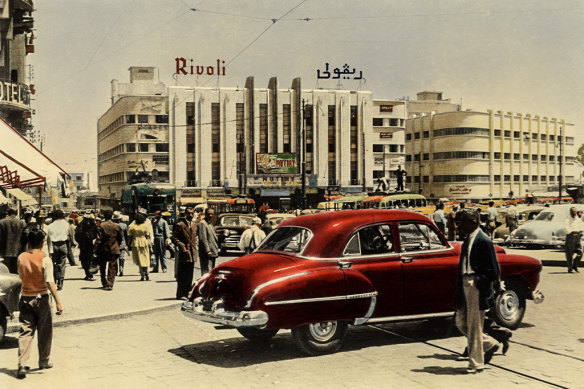
The centre of Beirut in 1954.Credit: Getty Images, digitally tinted
With all eyes on Gaza, what’s been going on in Lebanon?
Think of Dubai, with its six-star hotels, luxury shopping and sandy beaches lapped by clear seas the temperature of bathwater. That was Beirut during its heyday, a couple of glorious decades from the mid-1950s when the Mediterranean-facing Lebanese capital earned a reputation for glamour, sophistication and more than a little East-meets-West intrigue.
There was no shortage of hotspots favoured by visiting celebrities, such as the seafront Italian restaurant La Gondola, where the waiters wore white coats and bow ties, the nightclubs on the Rue de Phenicie, the Casino du Liban, a short drive out of town, and the gaggle of modernist-era hotels with their oasis-like swimming pools where tourists could lounge around in swimwear and drink cocktails – a far cry from censorious life elsewhere in the region.
Pick of the pack might have been the St Georges, which opened in 1934 (during the French occupation of Lebanon, from 1920 to 1943, hence the profusion of Gallic names) and hit its stride in the 1960s as a home away from home for royalty, film stars and even spies: British double agent Kim Philby famously, if recklessly, propped up the bar there after he fled to Beirut in 1955. “The hotel was majestic and its location along the sea was magical,” Georges Corm, a Lebanese economist and historian told Lebanese news site Naharnet in 2011. “It was the rendezvous of Beirut’s creme de la creme.”
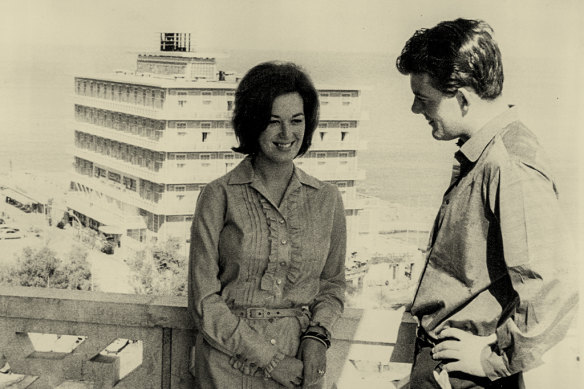
Diamond heiress Mary Oppenheimer and husband, rugby star Gordon Waddell, at the Beirut hotel Phoenicia with the St Georges hotel in the distance in 1965. Credit: United Press International, digitally tinted
Today, the St Georges is a pockmarked shadow of its former self: decrepit but still standing, a bit like the city itself, scarred by the internal and regional conflicts that first erupted in the civil war of 1975. Indeed, in the first two years of that war, the St Georges and several nearby luxury hotels became a field of fire as militiamen from various opposing factions commandeered guest rooms to rain bullets on neighbouring buildings in what became known as the “Battle of the Hotels”.
Some of the ruins are seen today as historical relics, says Joan Torres, who takes small groups of travellers from a start point in Beirut into less-visited neighbouring countries with the tour company Against the Compass Expeditions. “There are bullet holes everywhere,” says Torres. “But at the same time, it looks like a southern European city – the same kind of bars and kind of restaurants, same kind of vibe.”
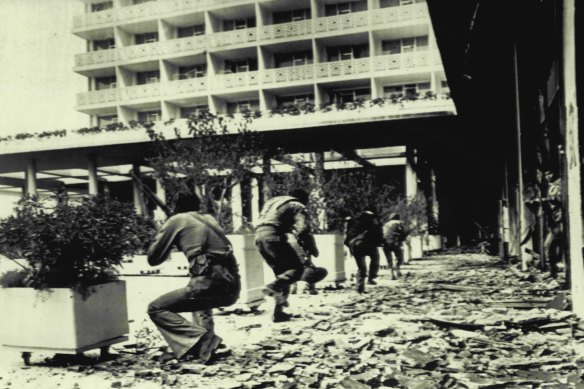
Gunmen by the pool at the Phoenicia fire at opponents in the nearby Holiday Inn in the first year of civil war in 1975.Credit: AP, digitally tinted
The Shiite Muslim group we know today as Hezbollah began to emerge around 1980. (Shiite Islam is the second-largest branch of the Islamic faith, currently dominant in Iran and Iraq. Sunnis are the largest branch, making up most of the world’s Muslims, including those in Saudi Arabia. Sunni and Shiite Muslims diverged in the 7th century CE after a disagreement over who could rightly succeed the Prophet Muhammad as leader.)
Initially just one of many splintered warring Christian and Muslim militia factions, Hezbollah (meaning “Party of God”) became of interest to the major Shiite government in the region, that of Iran’s Ayatollah Khomeini, which began to supply it with funds, training and weapons, both to expand Iran’s influence and to provoke Western powers with interests in the region. Iran’s so-called Axis of Resistance also includes the Syrian government of Bashar al-Assad and the militant groups Hamas (in Gaza), the Houthis (in Yemen) and several smaller pro-Iranian militias in Iraq.
The so-called Blue Line was marked by blue barrels and is now considered the de facto border.
Hezbollah grew in influence from the early 1980s during Israel’s occupation of south Lebanon, which was a response to border skirmishes with the Palestine Liberation Organisation but which escalated into a siege of Beirut. In 1985, Israel withdrew to southern Lebanon, where its forces remained until 2000 in what it called a security zone. “The extent of the destruction and the difficult conditions that the Israeli occupation imposed on the Lebanese population, particularly the Shiite population living in south Lebanon, generated strong popular support for Hezbollah,” observes the Red Cross.
Hezbollah carried out guerilla raids on the occupiers while mounting a series of deadly bombing attacks on Western targets, including a 1984 blast at the US embassy in Beirut that claimed dozens of lives. Its 1985 manifesto called for the expulsion of Western powers from Lebanon and the destruction of the Israeli state, and pledged allegiance to Iran’s supreme leader. In 2003, Australia listed Hezbollah’s military arm as a terrorist organisation. Israel withdrew from Lebanon in 2000 behind the so-called Blue Line, a demarcation between the two countries drawn up by the United Nations that was marked by blue barrels and which is now considered the de facto border.
But Hezbollah was far from done. In 2006, it abducted two Israeli troops from across the Blue Line. “Hezbollah had carried out its plan perfectly,” write Amos Harel and Avi Issacharoff in 34 Days, their 2009 account of what became a month-long war. “An effective attack on the patrol moving along the security fence that runs parallel to the border; a simultaneous decoy operation consisting of heavy shelling along the border and a decommissioning of all the observation cameras that were set up near the border. Together, all these actions created the commotion necessary to provide time for a successful abduction.”
Israel then invaded southern Lebanon again. According to the Red Cross, its air force flew more than 12,000 combat missions; its navy fired 2500 shells, and its army fired over 100,000 shells, destroying civilian infrastructure including roads, bridges, the international airport, ports, water and sewage treatment plants, electrical facilities, fuel stations, commercial structures, schools and hospitals. Hezbollah – and Lebanese civilians – ultimately suffered 1200 casualties while around 165 Israeli soldiers and civilians died, according to the Brookings Institution in the US.
‘No state institution – including the Lebanese Armed Forces – will openly challenge Hezbollah’s domestic credibility with its own Shiite constituency.’
But the militia group gained prestige by inflicting significant damage, including to 52 of Israel’s vaunted “Merkava” tanks with anti-tank rockets – a textbook demonstration of what military analysts call asymmetric warfare. In the aftermath, Iran and Syria were encouraged to send Hezbollah ever more advanced weapons to bolster its domestic and regional influence, writes Aram Nerguizian, a senior adviser at the Malcolm H. Kerr Carnegie Middle East Centre based in Beirut. A 2006 UN Security Council resolution that called for Hezbollah to be disarmed was ignored or proved impossible to carry out.
In the years since, Hezbollah has grown into a civil-military hybrid organisation that wields both legitimate political influence, at local and national levels of government, and shadowy military power, controlling a militia that analysts now consider to be among the world’s most capable irregular armies. The Council on Foreign Relations describes Hezbollah as a “state within a state”.
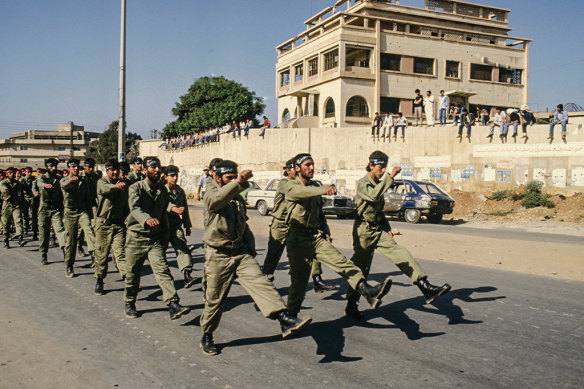
Hezbollah members on parade near Beirut in 1986.Credit: Getty Images, digitally tinted
Hezbollah’s activities in the community have a “parallel structure” to Lebanon’s government programs, says Anas Iqtait, a Middle Eastern studies lecturer at ANU. “Hezbollah has its own public service,” he notes. They raise funds through “zakat” – the religious duty of wealthy individuals to make donations – along with various other means. “They then recycle this through their public services, providing education, providing food for the needy, providing orphanages,” he says. “It’s really important to stress that this is not done by the military wing of Hezbollah.” Those in political roles, he says, “work within the confines of the Lebanese political system and the bureaucracy” such as the 13 Hezbollah MPs who are aligned with a fellow Shiite Muslim faction and the Christian party, the Free Patriotic Movement. Until 2022, a coalition of Hezbollah and its allies had a majority in Lebanon’s parliament.
Hezbollah’s militia seems to operate largely untroubled by the regular Lebanese army, which has yet to intervene in the current conflict. Writes Nerguizian: “No state institution – including the Lebanese Armed Forces – will openly challenge Hezbollah’s domestic credibility with its own Shiite constituency.”
In 2020, ammonium nitrate stored in a warehouse at the Port of Beirut exploded, killing more than 200 people and injuring around 7000 (the blast was felt in neighbouring Syria and Israel and heard in Cyprus, about 250 kilometres away). Prime minister Hassan Diab and the Lebanese cabinet subsequently resigned.
Today’s government, headed by Prime Minister Najib Mikati, remains hamstrung by its inability to choose a president (partly due to a complex system of government that followed France’s exit in 1943, which guaranteed not only each religious community a proportion of the seats in parliament but also bickering and stalemates). The economy is a basket case (annual inflation reached 268.78 per cent in April 2023 and is 35 per cent today). The nation struggles to manage a refugee crisis caused by spillover from the civil war in neighbouring Syria. Polling by Arab Barometer in 2023 found 80 per cent of Lebanese people reported problems getting enough food; 92 per cent reported weekly electricity outages.
In such a political vacuum, Hezbollah “effectively governs most of the country”, write MaryClare Roche and Michael Robbins in the journal Foreign Affairs.
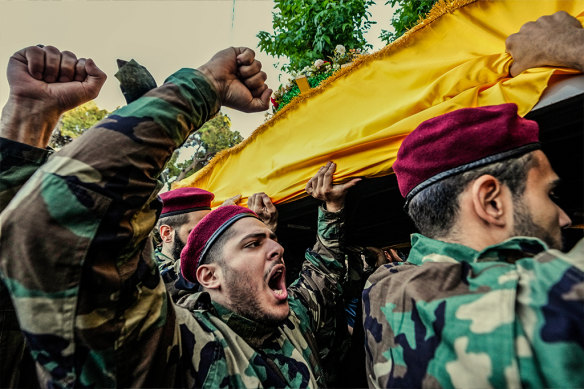
Hezbollah members carry the coffins of two commanders during a funeral procession in Beirut’s southern suburbs on September 25. Credit: AP, digitally tinted
Why has Israel escalated its conflict with Hezbollah now?
On September 20, Israeli forces levelled two buildings in Beirut, killing at least 45 people, according to Lebanon’s health ministry. The IDF said the strike killed Hezbollah’s head of operations. On September 23, the IDF sent text messages warning Lebanese residents in areas of the country’s south to evacuate and later reported it hit 1600 Hezbollah targets.
Israel says Hezbollah has turned “thousands of homes” in southern Lebanon into “terror bases” that store its weapons, which include small arms, rockets and anti-tank grenades. “They make that claim,” says Ian Parmeter, a former Australian ambassador to Lebanon. “I don’t know if that’s independently true but, essentially, Israel, when it hits a target where there are civilians, it has been aiming to take out something which will do damage to Israel.”
Hezbollah is believed to have laid down defensive positions overlooking the border region and to have dug a network of tunnels, such as those built by Hamas in Gaza, to use in the event of a ground war. Israeli Arab-Jewish analyst Alon Mizrahi told The Times of London that southern Lebanon was “the most well-designed, massively armed and strategically set up theatre of guerilla warfare probably anywhere in this world”.
While experts are unsure exactly how many of Hezbollah’s rockets and missiles are long-range and guided, on September 25, it fired a sophisticated Iranian missile towards Tel Aviv, which was intercepted not by Israel’s famous Iron Dome but by another of its defence systems, designed to thwart long-range attacks, known as David’s Sling.
But why the escalation on Israel’s part now? Analysts say there are a few reasons. Triggers might include military resources being freed up from the war in Gaza – the “intense phase” of which Israel Prime Minister Benjamin Netanyahu said in June was winding down, adding Israel would be able to “redeploy some forces to the north” on the border with Lebanon “primarily for defensive purposes”.
Hezbollah has been firing rockets over the border for almost a year, in support of Hamas in Gaza. Its first volley, a day after Hamas-led militants attacked Israel on October 7, 2023, appeared intended to divert Israeli military resources from retaliation in Gaza. Weeks later, then Hezbollah leader Nasrallah (killed in recent strikes) first remarked on the group’s intentions: “Some claim that we are about to engage in the war. I am telling you, we have been engaged in this battle since October 8.” He described it as part of the “Islamic resistance in Lebanon” against Israel’s retaliation and has insisted his organisation won’t stop firing into Israel until there is a ceasefire in Gaza.
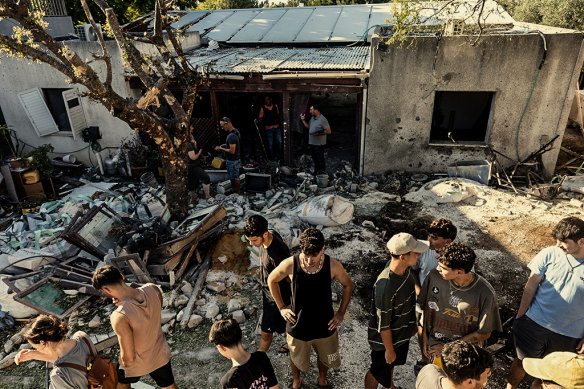
A house in Sa’ar in Israel hit by rocket fire from Lebanon on September 25. Credit: Getty Images, digitally tinted
Tit-for-tat strikes across the border have resulted in damage to settlements on both sides. Even before the recent escalation, the conflict had led to more than 60,000 Israelis evacuating from the north, according to the IDF, and more than 112,000 people being displaced in Lebanon, according to figures from aid organisation UNICEF.
Israel is yet to achieve its stated aims in Gaza – to destroy Hamas and to secure the return of Israeli hostages held by Hamas – but has significantly reduced Hamas’ capacity since October 7. (The health ministry in Gaza says the war has killed more than 40,000 Palestinians. The UN’s satellite service estimated in July that 63 per cent of the total structures in the Gaza Strip had been damaged.) During its Gaza operations, Israel has until now largely chosen to soak up Hezbollah’s pressure on its northern border, says Anas Iqtait. “Now Israel has less pressure emanating from Gaza, they have been able to shift resources north and focus on Hezbollah.”
‘Sooner rather than later someone was going to take a screwdriver to one of those devices and blow the whole complex operation ...’
Another reason for the timing of the escalation could be that Netanyahu has faced intense political pressure to secure northern Israel. (Israeli anger spiked after Hezbollah’s rockets killed 12 children on a soccer field in July.) The Israeli government has added to its war plan the return of citizens displaced from their homes. “The point that Netanyahu has made is that no country can accept that part of its territory is a no-go area,” says Parmeter, who cites this as the “ostensible reason” for Israel’s escalation. “We do understand that Netanyahu has been coming under a lot of pressure from the displaced Israelis.”
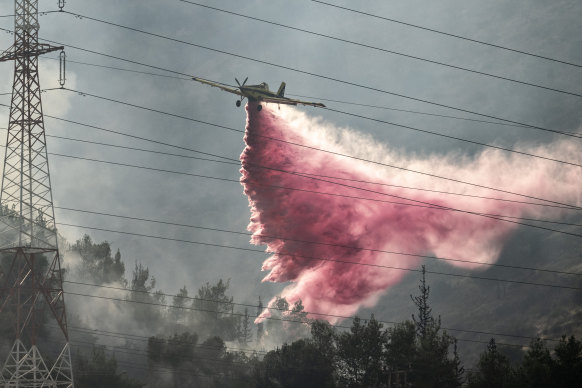
Israeli firefighters extinguish blazes in northern Israel caused by Hezbollah rockets in July. Credit: Anadolu via Getty Images
A third reason relates to the recent booby-trapped gadget attack, in which pagers and then walkie-talkies exploded in the hands and pockets of Hezbollah officers and their allies in what was widely thought to be an operation by Israel’s Mossad spy agency, killing a total of at least 32 people including four children and injuring thousands. “Israel planned the pager attacks as a first salvo of a broader military engagement with Hezbollah. Because it learned the intelligence was compromised, it decided to detonate the pagers,” Dr Sanam Vakil, director of the Middle East and North Africa Programme at Chatham House, says from London.
Israel was forced into a “use it or lose it” scenario, agrees Hussein Ibish, a senior resident scholar at the Arab Gulf States Institute in Washington. “The current theory is that Israel became aware of growing suspicions among Hezbollah members and associates about pagers overheating or not keeping their charges or something of that kind … sooner rather than later someone was going to take a screwdriver to one of those devices and blow the whole complex operation that was probably years in the making,” he says. “It’s possible the Israelis chose the timing very carefully and deliberately. But that’s not how it looks.”
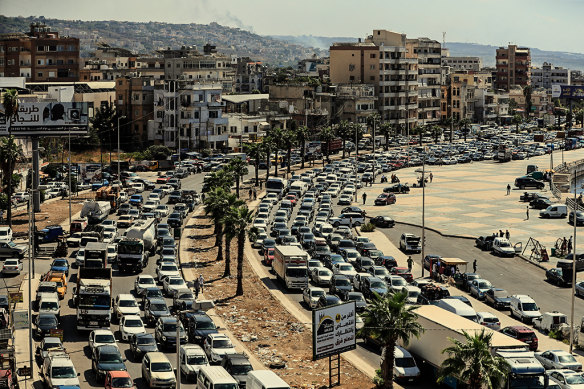
Lebanese families sit in a traffic jam as they flee southern villages amid Israeli airstrikes.Credit: AP, digitally tinted
Is a full-scale war inevitable?
The escalation of the conflict is reminiscent of Israel’s war with Lebanon in 2006, analysts tell us. In 2006, however, Israel sent forces on the ground into southern Lebanon, bombed bridges and roads and sent an airstrike to destroy the runways of Beirut’s airport. To date, the current conflict has been limited to rocket attacks by Hezbollah and airstrikes by Israel.
“[Israel] might believe that they can achieve more with a swift and limited ground campaign, or they might decide, ‘Listen, why even risk that, we’re doing fine’,” says Rodger Shanahan, a former Australian Defence Force member who served in Lebanon between 1998 and 2006. Others believe a ground campaign would be unwise. “Logically for Israel, it doesn’t make a lot of sense to be involved in two ground wars on different fronts in completely different parts of the country,” says Parmeter. “So they’re more likely to just continue hitting targets from the air.”
‘That’s what they’ll be trying to achieve; keeping Israeli civilians unable to return to the north.’
Neither side has given strong signals they’re interested in a truce. Hezbollah has spoken of an “open-ended battle”, which chimes with its long-stated goal of destroying Israel. “I think we’ll see Hezbollah trying to hunker down and do something against Israel as far as it can,” says Shanahan. “That’s what they’ll be trying to achieve; keeping Israeli civilians unable to return to the north.”
In making security in the north a military goal, Netanyahu has tethered his own credibility to achieving it. “It’s very important for Netanyahu to be able to restore his credibility as a defender of Israel’s security,” says Parmeter. “That’s his primary goal at this point.” Politically, it seems to be working, at least for now. Netanyahu’s Likud party is topping national polls, with analyst Dahlia Scheindlin arguing it is a consequence of Israel’s increasingly aggressive actions. “It looks like Israel is taking the initiative,” she told London’s Financial Times. “It’s true everybody gets terrified about the consequences. But each time, they have ultimately been far less than the Armageddon many worried about. And a lot of people come out of it thinking Netanyahu has … regained Israel’s footing.”
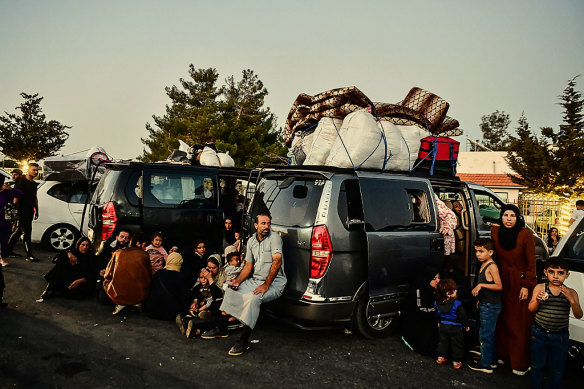
Lebanese families escaping airstrikes at a border crossing into Syria. Credit: Getty Images, digitally tinted
Ibish is more pointed. “What the Israelis are pursuing is the illusion of security through endless wars and occupations, in all directions, it would seem, rather than security itself. In reality, Israelis cannot have security without resolving the Palestinian issue through a mutual agreement.” In the background, Netanyahu is expected to begin testifying in his long-running corruption trial in December.
On September 25, Israel military chief Herzi Halevi told troops that airstrikes were a means “to prepare the ground for your possible entry”. Israel later rejected a call from Australia, France, the US, Britain and others, for a ceasefire. Just an hour before the bombing that killed Nasrallah, Netanyahu told the UN General Assembly: “Just imagine if terrorists turned El Paso and San Diego into ghost towns ... How long would the American government tolerate that? Yet Israel has been tolerating this intolerable situation for almost a year. Well, I’ve come here today to say: Enough is enough.”
‘The red lines for Iran would be a serious degradation of Hezbollah’s missile and rocket arsenal ...’
And what of Iran? Is it bluffing when it warns of “catastrophic consequences” if Israel sends in troops? The Iranian Foreign Minister, Abbas Araghchi, has warned that Tehran may no longer be as restrained as it has been in recent months. Unlikely, says Ibish. “Hezbollah exists in order to serve as a deterrent against and a retaliatory force in response to any attack on the Iranian homeland, especially its nuclear facilities,” he says. “Iran does not care much about details about the Lebanese-Israeli border.” That could change in future, he allows. “The red lines for Iran would be a serious degradation of Hezbollah’s missile and rocket arsenal through Israeli bombardment or other military action.”
For civilians in Lebanon, there’s an awful sense of conflict growing all over again. “Some people have fled [from the] south and already seen their next door neighbour or village homes destroyed … it is very nerve-racking. It is very devastating for people,” says Joseph Helou, professor of political science and international affairs at the Lebanese American University.
Filmmaker Daizy Gedeon told us the feeling in Beirut was sad and tense. “This will eventually end,” she said. “One day it will, everything does. But how much destruction, how much loss of life, how much debt, how much devastation is it going to cost?”
This Explainer was first published on September 26 and has been updated to reflect developments.
Get fascinating insights and explanations on the world’s most perplexing topics. Sign up for our weekly Explainer newsletter.
Let us explain
If you'd like some expert background on an issue or a news event, drop us a line at explainers@smh.com.au or explainers@theage.com.au. Read more explainers here.